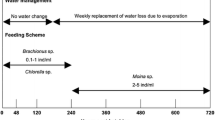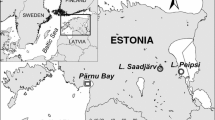Abstract
This study describes the influences of variations in life history traits and developmental patterns of Pseudepidalea viridis. The causes of this variation were investigated by comparing observed patterns of inter-populational differences. The aim of the study was to investigate whether embryos and larvae from different populations of P. viridis show the same pattern of development when they are reared in the same conditions in the laboratory. Egg masses of P. viridis were collected from four sites in Fars Province, Iran and reared in the same conditions. Samples from most of the developmental stages were fixed and clutch parameters were measured at early developmental stages. Morphological characters in embryos and larvae including egg diameter and growing size at different stages, as well as external gill, cement gland and mouth part structures were examined with light and scanning electron microscopy. Statistical analysis showed that the mean diameter of eggs and jelly coats were significantly different (P < 0.05) from each other in all four populations. In addition, variation among sites in developmental stage at age of embryos and larvae were found. The results also showed type B cement gland developmental pattern and significant differences in external gill filaments amongst the populations. The dental formula was 2 (2)/3 and revealed no differences in the number and situation of dental rows among the populations. Our data suggest that local adaptation may be responsible for life history and morphometric and morphological variations among eggs, embryos and larvae of P. viridis.






Similar content being viewed by others
References
Altig R, McDiarmid RW (1999) Body plan: development and morphology. In: McDiarmid RW, Altig R (eds) Tadpoles: the biology of anuran larvae. The University of Chicago Press, Chicago, pp 24–51
Amanat M (2008) A comparative study of embryonic and larval development, also adult form in four populations of Rana ridibunda (Order: Anura) in Fars Province. MSc, Shiraz University, Shiraz, Iran
Amanat M, Nokhbatolfoghahai M, Esmaeili HR (2014) Intraspecific variation in Pelophylax ridibunda (Rana ridibunda) in Southern Iran: life history and developmental patterns. Iranian J Animal Biosyst 10(1):11–28
Andren C, Henrikson L, Olsson M, Nilson G (1988) Effects of pH and aluminium on embryonic and early larval stages of Swedish brown frogs Rana arvalis, R. temporaria and R. dalmatina. Holoarctic Ecol 2:127–135
Baloutch M, Kami HG (2007) Amphibians of Iran. Tehran University Publications, Tehran
Beattie RC, Tyler-Jones R, Baxter MJ (1992) The effects of pH, aluminium concentration and temperature on the embryonic development of the European common frog, Rana temporaria. J Zool London 228:557–570
Berven KA (1982a) The genetic basis of altitudinal variation in the wood frog Rana sylvatica. I. An experimental analysis of life history traits. Evolution 36:962–983
Berven KA (1982b) The genetic basis of altitudinal variation in the wood frog Rana sylvatica. II. An experimental analysis of larval development. Oecologia 52:360–369
Berven KA, Gill DE (1983) Interpreting geographic variation in life-history traits. Am Zool 23:85–97
Berven KA, Gill DE, Smith-Gill SJ (1979) Counter gradient selection in the green frog, Rana clamitans. Evolution 33:609–623
Broomhall SD (2004) Egg temperature modifies predator avoidance and the effects of the insecticide endosulfan on tadpoles of an Australian frog. J Appl Ecol 41:105–113
Castellano S, Glacoma C, Dujsebayeva T, Odierna G, Balletto E (1998) Morphometrical and acoustical comparison between diploid and tetraploid green toads. Biol J Linnean Soc 63:257–281
Castellano S, Cucco M, Giacoma C (2004) Reproductive investment of female green toads (Bufo viridis). J Copeia 3:659–664
Clark KL, Hall RJ (1985) Effects of elevated hydrogen ion and aluminium concentration on the survival of amphibian embryos and larvae. Can J Zool 63:1l6–123
Crump ML (1974) Reproductive strategies in a tropical anuran community. Miscellaneous publication, University of Kansas, Museum Natural History, vol 61, pp 1–68
Duellman WE, Trueb L (1994) Biology of amphibians. The Johns Hopkins University Press, Baltimore
Freda J, Dunson WA (1985) Field and laboratory studies of ion balance and growth rates of Ranid tadpoles chronically exposed to low pH. Copeia 1985(2):415–423
Frisbie MP, Costanzo JP, Lee RE (2000) Physiological and ecological aspects of low temperature tolerance in embryos of the wood frog, Rana sylvatica. Can J Zool 78:1032–1041
Frost DR (2010) Amphibian Species of the World: an Online Reference. Resource document. American Museum of Natural History, New York, USA. http://research.amnh.org/vz/herpetology/amphibia. Accessed 28 December 2015
Gosner KL (1960) A simplified table for staging anuran embryos and larvae with notes on identification. Herpetologica 16:183–190
Hall RJ, Henry PFP (1992) Review: assessing effects of pesticides on amphibians and reptiles: status and needs. Herpetol J 2(3):65–71
Hillis DM (1982) Morphological differentiation and adaptation of the larvae of Rana berlandieri and Rana sphenocephala (Rana pipiens complex) in sympatry. Copeia 1982:168–174
Holcombe GW, Phipps GL, Sulaiman AH, Hoffman AD (1987) Simultaneous multiple species testing: acute toxicity of 13 chemicals to 12 diverse freshwater amphibian, fish and invertebrate families. Arch Environ Contam Toxicol 16(6):697–710
Howard JH, Wallace RL (1985) Life history characteristics of populations of the long-toed salamander (Ambystoma macrodactylum) from different altitudes. Am Midland Natural J 113:361–373
Jennings RD, Scott NJ (1993) Ecologically correlated morphological variation in tadpoles of the leopard frog, Rana chiricahuensis. J Herpetol 27:285–293
Kaplan RH (1980) The implications of ovum size variability for offspring fitness and clutch size within several populations of salamanders (Ambystoma). Evolution 34:51–64
Kaplan BH, King EG (1997) Egg size is a developmentally plastic trait: evidence from long term studies in the frog Bombina orientalis. Herpetologica 53:149–165
Khan MS, Mofti SA (1994) Oral disc morphology of amphibian tadpole and its functional correlates. Pakistan J Zool 26:25–30
Kluge AG (1981) The life history, social organization, and parental behaviour of Hyla rosenbergi Boulenger, a nest-building gladiator frog. Miscellaneous publication-Museum Zoology University of Michigan, vol 160, pp 1–170
Kovacs EH, Sas I (2010) Aspects of breeding activity of Bufo viridis in an urban habitat: a case study in Oradea, Romania. Biharean Biologist 4(1):73–77
Kozlowska M (1971) Differences in the reproductive biology of mountain and lowland common frogs Rana temporaria. Acta Biologica Cracoviensia Seriea Zoologia 14:17–32
Kuramoto M (1978) Correlation of quantitative parameters of fecundity in amphibians. Evolution 32(2):287–296
Laugen AT, Laurila A, Räsänen K, Merilä J (2003) Latitudinal countergradient variation in the common frog (Rana temporaria) development rates evidence for local adaptation. J Evol Biol 16:996–1005
Laurila A, Pakkasmaa S, Merila J (2001) Influence of seasonal time constraints on growth and development of common frog tadpoles: a photoperiod experiment. Oikos 95:451–460
Licht LE (1975) Comparative life history features of the western spotted frog, Rana pretiosa, from low- and high-elevation populations. Can J Zool 53:1254–1257
McDiarmid W, Altig R (1999) Tadpoles: The Biology of Anuran Larvae. The University of Chicago Press, Chicago
Miaud C, Guyetant R, Elmberg J (1999) Variation in life-history traits in the common frog Rana temporaria (Amphibia: anura): a literature review and new data from the French Alps. J Zool London 249:61–73
Moore JA (1939) Temperature tolerance and rates of development in the eggs of Amphibia. Ecology 20:459–478
Morrison C, Hero JM (2003) Geographic variation in life-history characteristics of amphibians: a review. J Anim Ecol 72:270–279
Nevo E, Schneider H (1976) Maiting call of green toads in Israel and its ecological correlate. J Zool London 178:133–145
Nokhbatolfoghahai M (2009). Developmental study of amphibians in Fars Province. Report Project, Shiraz University, Shiraz
Nokhbatolfoghahai M, Downie JR (2005) Larval cement gland of frogs: comparative development and morphology. J Morphol 263:270–283
Nokhbatolfoghahai M, Downie JR (2008) The external gills of anuran amphibians: comparative morphology and ultrastructure. J Morphol 269:1197–1213
Pahkala M, Laurila A, Bjorn LO, Merilä J (2001) Effects of ultraviolet-B radiation and pH on early development of the moor frog Rana arvalis. J Appl Ecol 38:628–636
Pahkala M, Räsänen K, Laurila A, Johanson ULF, Bjorn LO, Merilä J (2002) Lethal and sublethal effects of UV-B/pH synergism on common frog embryos. Conserv Biol 16:1063–1073
Palo JU, Schmeller DS, Laurila A, Primmer CR, Kuzmin SL, Merilä J (2004) High degree of population subdivision in a widespread amphibian. Mol Ecol 13:2631–2644
Pierce BA, Hoskins JB, Epstein E (1984) Acid tolerance in Connecticut wood frogs (Rana sylvatica). J Herpetol 18(2):159–167
Portnoy JW (1990) Breeding biology of the spotted salamander Ambystoma maculatum (Shaw) in acidic temporary ponds at Cape Cod, USA. Biol Conserv 53(1):61–75
Richter-Boix A, Tejedo M, Rezende E (2011) Evolution and plasticity of anuran larval development in response to desiccation: a comparative analysis. Ecology and Evolution, published by Blackwell publishing Ltd, pp 15–25. http://www.ncbi.nlm.nih.gov/pmc/articles/PMC3287374/pdf/ece30001-0015.pdf. Accessed 28 Dec 2015
Ryser J (1996) Comparative life histories of a low- and a high-elevation population of the common frog Rana temporaria. Amphibia–Reptilia 17: 183–195
Salthe SN, Duellman WE (1973) Quantitative constraints associated with reproductive modes in anurans. In: Vial JL (ed) Evolutionary biology of the anurans. University of Missouri Press, Columbia, pp 229–249
Sanuy D, Oromí N, Galofré A (2008) Effects of temperature on embryonic and larval development and growth in the natterjack toad (Bufo calamita) in a semi–arid zone. J Animal Biodivers Conserv 31:41–46
Sinsch U, Lescovar C, Drobig A, Konig A, Gross W (2007) Life-history traits in green toad (Bufo viridis) populations: indicators of habitat quality. Can J Zool 85:665–673
Stock M, Steinlein C, Lamatsch DK, Schartl M, Schmid M (2005) Multiple origin of tetraploid taxa in the Eurasian Bufo viridis subgroup. Genetica 124:255–272
Thumm K, Mahony M (2005) Is variable egg size the proximate cause of diversified bet-hedging in the hatching dynamics of the red-crowned toadlet (Pseudophryne australis) (Anura: Myobatrachidae). Herpetologica 61:9–19
Travis J (1983) Variation in development patterns of larval anurans in temporary ponds. I. persistent variation within a Hyla gratiosa population. Evolution 37:496–512
Tyler MS (1994) Developmental biology: a guide for experimental study. Sinauer Associates, Massachusetts
Volpe EP (1957) Embryonic temperature adaptations in highland Rana pipiens. Am Nat 91:303–309
Voss SR (1993) Effect of temperature on body size, developmental stage, and timing of hatching in Ambystoma maculatum. J Herpetol 27:329–333
Acknowledgments
We thank M. A. Hooshmand and J. Dialameh for their help in collecting spawns from the Fars area. We also thank Dr. M. Monsefi for her technical assistance and advice. This project was supported by Shiraz University.
Author information
Authors and Affiliations
Corresponding author
Rights and permissions
About this article
Cite this article
Badpayman Jahromi, M., Nokhbatolfoghahai, M. & Esmaeili, H.R. Intra-Specific Variation in Pseudepidalea viridis in Fars Province, Iran: Life History and Developmental Patterns. Iran. J. Sci. Technol. Trans. Sci. 40, 125–136 (2016). https://doi.org/10.1007/s40995-016-0001-3
Received:
Accepted:
Published:
Issue Date:
DOI: https://doi.org/10.1007/s40995-016-0001-3




